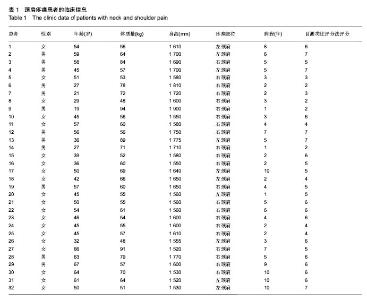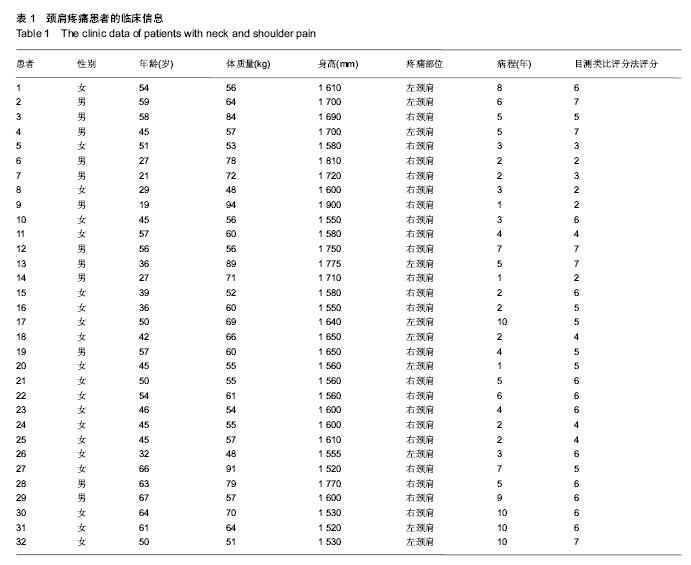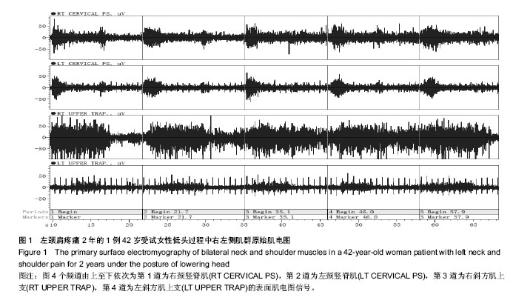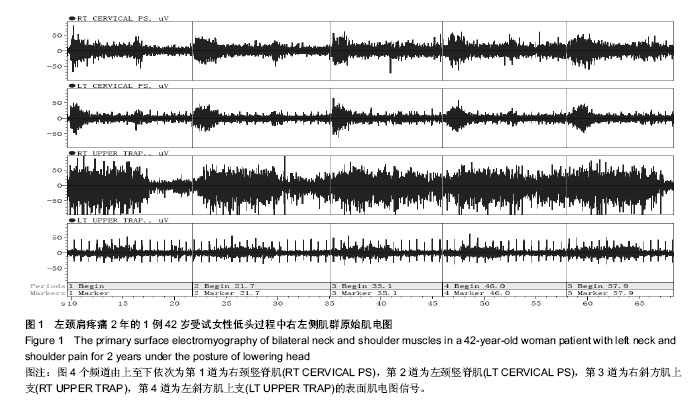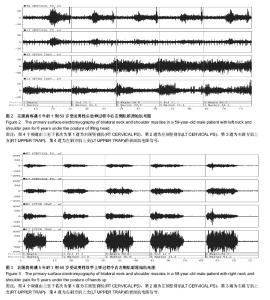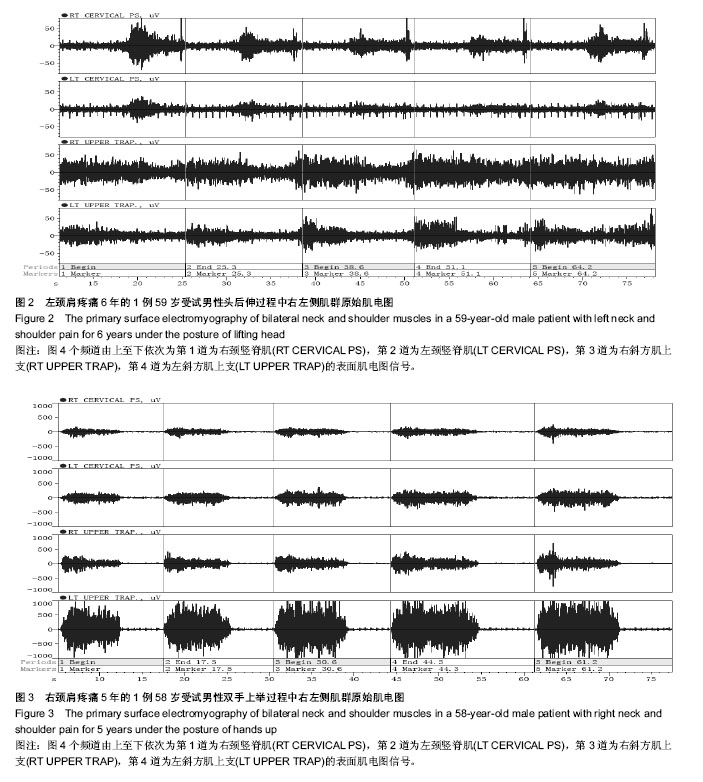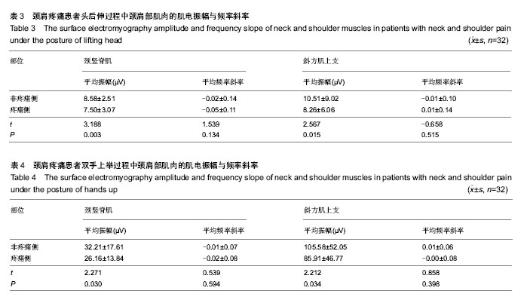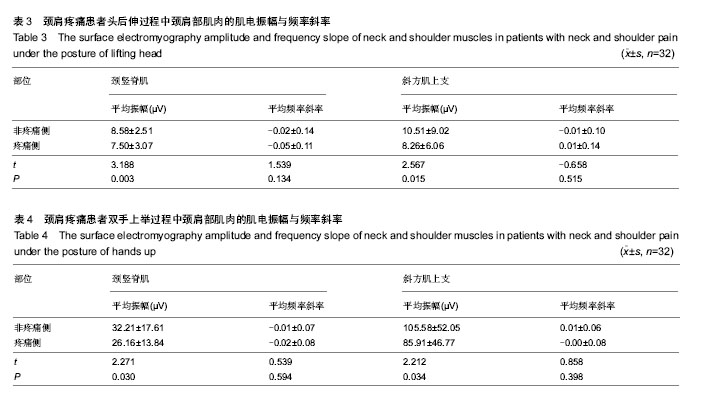| [1] 曲延蓉,马晓红,徐杰.某企业静态作业工人肩痛的调查[J].中国工业医学杂志,2004,17(3):195-196.
[2] da Costa BR, Vieira ER. Stretching to reduce work-related musculoskeletal disorders: a systematic review. J Rehabil Med. 2008;40(5):321-328.
[3] 郑志新,王军,侯京山,等.温经养血法治疗颈肩部慢性软组织损伤性疼痛的随机对照研究[J].中西医结合学报,2011,9(2):153-157.
[4] 柏伟,谢飞,彭渊源.颈肩背部软组织损伤性疼痛112例临床分析[J].中国疗养医学,2011,20(8):742.
[5] 刘军,范庆花,徐鲁云.经筋恢刺法治疗颈肌筋膜疼痛综合征68例[J].中国中医急症,2011,20(11):1864.
[6] 吕强,朱清广,房敏,等.微调手法对颈椎病患者颈肌疲劳程度影响研究[J].时珍国医国药,2011,22(10):2406-2407.
[7] 张非若,王生,何丽华,等.缝纫女工颈肩部肌肉的表面肌电研究[J].中华劳动卫生职业病杂志,2011,29(3):171-175.
[8] 朱清广,房敏,沈国权,等.手法对颈椎病患者颈肌力学性能及疲劳程度影响研究[J]. 中国骨伤,2012,25(1):18-21.
[9] 陈杏云,王开强.公共保健操对颈肩综合征针刀术后患者康复效果的影响[J].护理学杂志2012,27(6):74-75.
[10] 李典翰,房敏,朱清广,等.推拿手法对颈椎病患者颈肌疲劳程度影响研究[J].北京中医药,2012,31(1):10-12.
[11] 杨盛宇,刘佳,黄蛟,等.温经通络方联合拨经推拿手法对颈椎病患者颈肌力学性能的影响[J].陕西中医,2012,33(8).996-997.
[12] 李克刚.黄芪桂枝五物汤治疗颈肩肌筋膜疼痛综合征45例[J].中国民间疗法,2013,21(12):43.
[13] 王念辉.中年出租车司机颈部肌肉表面的肌电测试[J].中国组织工程研究与临床康复,2010,14(33):6238-6242.
[14] Villanueva MB, Jonai H, Sotoyama M, et al. Sitting posture and neck and shoulder muscle activities at different screen height settings of the visual display terminal. Ind Health. 1997;35(3):330-336.
[15] Farina D, Merletti R, Enoka RM. The extraction of neural strategies from the surface EMG. J Appl Physiol (1985). 2004;96(4):1486-1495.
[16] Kroon GW, Naeije M. Recovery of the human biceps electromyogram after heavy eccentric, concentric or isometric exercise. Eur J Appl Physiol Occup Physiol. 1991;63(6): 444-448.
[17] Geldhof E, Cardon G, De Bourdeaudhuij I, et al. Effects of back posture education on elementary schoolchildren's back function. Eur Spine J. 2007;16(6):829-839.
[18] 张革新,曲延蓉.静态坐位手动作业工人颈肩痛患病调查[J].中国公共卫生,2008,24(5):564.
[19] 罗少波.“耸肩抬头”防治颈椎病[J].按摩与导引, 2009,25(3): 22-23.
[20] 安雅婷.按摩治疗颈椎病2000例的临床观察[J]. 按摩与导引, 2008,24(6):21-22.
[21] 陈鹏,孙立山,李冬青,等.表面肌电图在腰椎间盘突出症手术效果评定中的作用[J].山东医药,2006,46(21):71-72.
[22] 吕静,张跃,汤健,等.表面肌电图在痉挛型脑瘫患儿坐位平衡功能疗效评估中的应用[J].中华物理医学与康复杂志, 2010,32(3): 223-225.
[23] 缪萍.表面肌电图在髌股疼痛综合征中的应用进展[J].医学综述, 2012,18(21):3652-3654.
[24] 王荣丽,王宁华,谢斌.表面肌电图在帕金森病中的应用[J].中国康复理论与实践,2012,18(2):144-148.
[25] 刘玲玲,帅浪,冯珍.正常成人咽期吞咽相关肌群的表面肌电图研究[J].中华物理医学与康复杂志,2013,35(12):963-966.
[26] 穆景颂,倪朝民,夏清,等.表面肌电在腰椎间盘突出症患者功能评定中的应用[J].中国康复理论与实践,2010,16(3):266-269.
[27] 李彦萍,钱敏,沈嘉平.综合物理疗法治疗飞行员颈椎病临床观察[J].中国疗养医学,2011,20(1):66-67.
[28] 章春根.按摩治疗肩颈部软组织劳损192例[J].按摩与导引,2008, 24(2):22-23.
[29] 高庆,方诗元.肌电图评价腰椎间盘突出症的临床价值[J].中国组织工程研究与临床康复,2011,15(13):2438-2441.
[30] 冯宇,高燕,冯天有.矫形鞋辅助手法治疗腰椎间盘突出症的临床研究[J].中国骨伤,2012,25(1):28-31.
[31] 冯能,李跃红,缪芸,等.慢性腰痛患者站立位躯干屈伸运动时腰背肌的功能变化研究[J].中国康复医学杂志,2012,27(7):600-604.
[32] 谬萍,王楚怀,许轶,等.髌股疼痛综合征股外侧肌及股内斜肌的表面肌电特征[J].广东医学,2012,33(24):3755-3757.
[33] 范年春,陆爱云.表面肌电图在游泳动作研究中的应用[J].中国运动医学杂志,2011,30(4):383-386.
[34] 毕霞,王雪强,刘志浩,等.不同运动方式对腰腹部肌群表面肌电信号的影响[J].中华物理医学与康复杂志,2012,34(3):208-211.
[35] 马胜.不同负荷运动中下肢肌表面肌电图的变化[J].中国组织工程研究,2013,17(7):1259-1264.
[36] 李伟,尚学东,鲁智勇,等.优秀乒乓球运动员肩胛肌失衡的表面肌电特点[J].中国康复医学杂志,2013,28(l):40-46.
[37] 陈谦.sEMG技术在颈部肌肉活动评价中的应用[J].北京体育大学学报,2008,31(2):226-228.
[38] Østensvik T, Veiersted KB, Nilsen P. A method to quantify frequency and duration of sustained low-level muscle activity as a risk factor for musculoskeletal discomfort. J Electromyogr Kinesiol. 2009;19(2):283-294.
[39] Cifrek M, Medved V, Tonkovi? S, et al. Surface EMG based muscle fatigue evaluation in biomechanics. Clin Biomech (Bristol, Avon). 2009;24(4):327-340.
[40] 邢方印,张莉,卢虎英,等.基于表面肌电图的针刺缓解腓肠肌群疲劳的评价[J].中国康复理论与实践2012,18(6):588-590.
[41] 赵鹏飞,马强,陈学伟,等.提举强度致肩部疲劳的肌电特征分析[J].中华劳动卫生职业病杂志,2012,30(7):501-503.
[42] Vollenbroek-Hutten M, Hermens H, Voerman G, et al. Are changes in pain induced by myofeedback training related to changes in muscle activation patterns in patients with work-related myalgia? Eur J Appl Physiol. 2006;96(2): 209-215.
[43] Pool JJ, Ostelo RW, Hoving JL, et al. Minimal clinically important change of the Neck Disability Index and the Numerical Rating Scale for patients with neck pain. Spine (Phila Pa 1976). 2007;32(26):3047-3051.
[44] 马超,燕铁斌,Grace P.Y.Szeto.颈肩部疼痛及功能障碍与表面肌电图之间的关系[J].中华物理医学与康复杂志, 2008,30(12): 823-826.
[45] 葛树旺,陈松林,付圣灵,等.手臂静态姿势负荷的肌电实验研究[J].工业卫生与职业病,2008,34(4):220-223.
[46] 张非若,陶鑫,王波,等.驾驶人背部肌肉负荷定量研究[J].中国生物医学工程学报,2013,32(6):685-691.
[47] 孙湖,刘立安.应用表面肌电图评价针刺治疗周围性面瘫的临床研究[J].中医临床研究,2012,4(4):24-25.
[48] 杜红根,叶树良,徐金元,等.表面肌电图在中医脊柱平衡法治疗青少年特发性脊柱侧凸症中的应用[J].中国骨伤, 2013,26(11): 914-917.
[49] 许晶莉,范艳萍,代早荣.表面肌电图在脑瘫患儿疗效评估中的应用研究[J].中国康复,2013,28(1):29-32.
[50] 夏清,袁海,王修敏,等.表面肌电在脑卒中患者肢体功能障碍评价中的意义[J].中国康复医学杂志,2013,28(11):1046-1050.
[51] 吴洪,冉春风.表面肌电图在运动训练中的应用[J].中国组织工程研究与临床康复,2008,12(39):7739-7743。
[52] 马庆春,李林.表面肌电图在儿童神经康复医学中的应用现状[J].中国康复理论与实践,2010,16(12):1144-1146.
[53] 穆景颂,倪朝民.下背痛表面肌电的应用研究[J].安徽医学, 2010, 31(3):287-289.
[54] Voerman GE, Vollenbroek-Hutten MM, Hermens HJ. Changes in pain, disability, and muscle activation patterns in chronic whiplash patients after ambulant myofeedback training. Clin J Pain. 2006;22(7):656-663.
[55] Marquis N, Debigaré R, Bouyer L, et al. Physiology of walking in patients with moderate to severe chronic obstructive pulmonary disease. Med Sci Sports Exerc. 2009;41(8): 1540-1548.
[56] 卫杰,赵平,周卫.表面肌电图在腰背痛临床研究中的应用[J].中国骨伤,2007,20(10):723-725.
[57] 张非若,丁嘉顺,戴文涛,等.重复作业上肢肌肉疲劳的表面肌电实验研究[J].工业卫生与职业病,2007,33(1):5-8.
[58] 戴文涛,赵晓蓉,张非若,等.重复性作业前臂肌肉疲劳及危险因素的表面肌电分析[J].工业卫生与职业病,2006,32(4):195-198.
[59] 刘存根,彭再如,刘雪勇.颈椎操对大学生颈型颈椎病干预效果分析[J].中国运动医学杂志,2011,30(3):279-281.
[60] 张纳新.颈部康复操训练治疗颈型颈椎病患者的疗效观察[J].中华物理医学与康复杂志,2011,33(1):68-69. |
